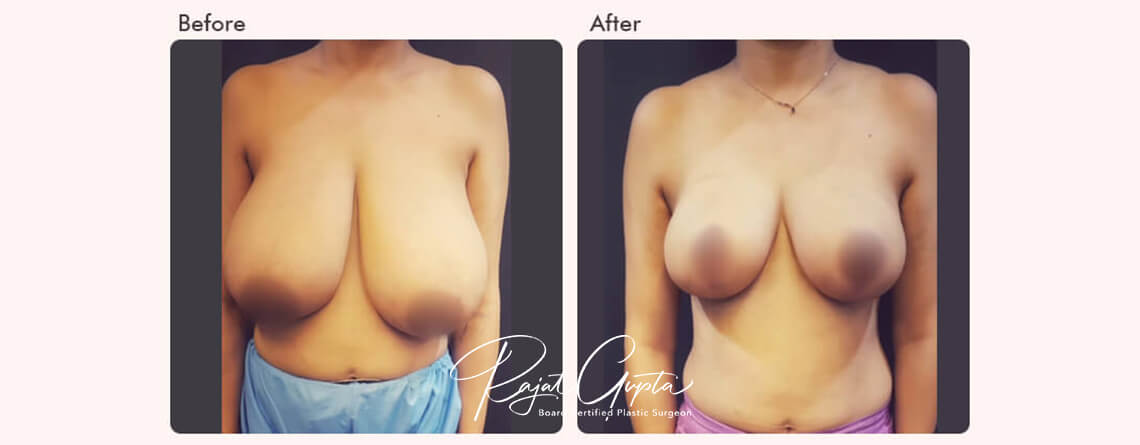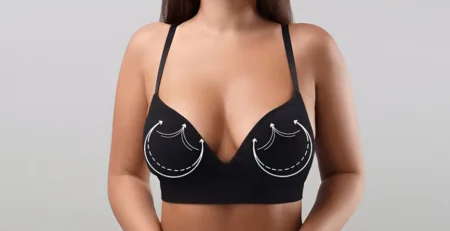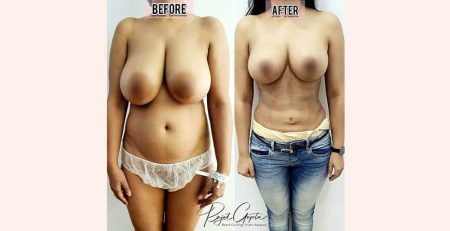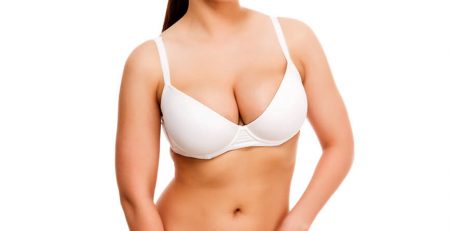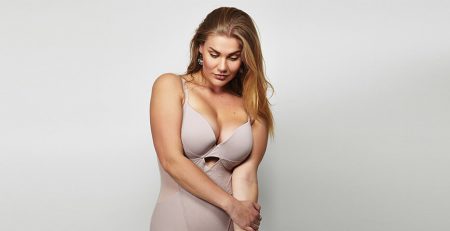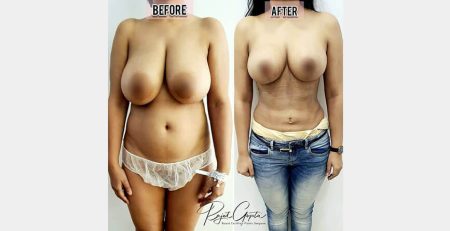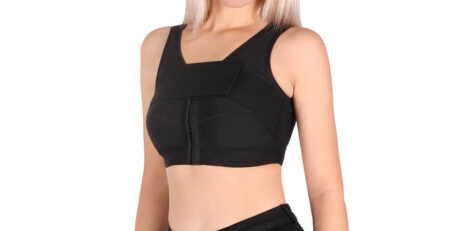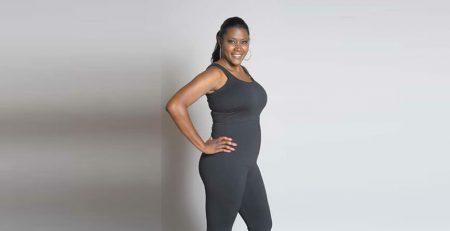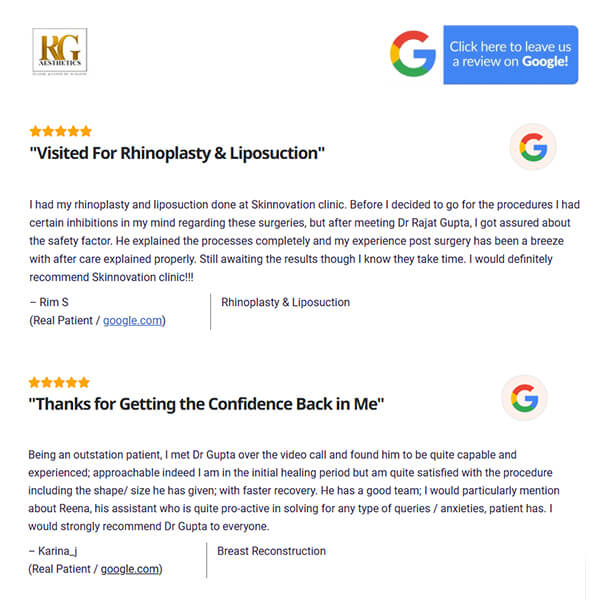RG Flap Technique Demystified: Achieving Natural Upper-Breast Fullness
If you have been searching for RG flap breast reduction in Delhi because you want lighter breasts that still look youthful on top, this guide explains how the Dr Rajat Gupta RG flap technique restores shape while preserving sensation and blood supply. The approach builds upper pole projection with your own tissue, not implants, and it is planned to hold its form gracefully over time. That is the promise behind this dual flap technique breast reduction, and why so many women ask for it in consultation.
What is the RG Flap Technique?
Let’s understand why patients choose this method before we further explore the details.
- What it is: A dual flap technique breast reduction that preserves a reliable superior pedicle while creating a centrally based autologous flap; this flap is anchored to build the upper pole from your own tissue.
- Why it matters: Delivers the rounded look many want from an upper pole fullness breast reduction without implants; reduces bottom heaviness that traditional reductions can leave.
- Safety focus: Protects nipple–areola blood supply and sensation; designed by a breast reduction specialist Delhi patients trust for precision and longevity.
- Recovery at a glance: Walk the same day; desk work in about a week; routine workouts by week six after clearance; scar care and support bras are part of the plan.
- Who benefits most: Women seeking lift plus long-lasting upper fullness; those who want natural curves; and those who prefer to avoid implants.
In short, the Dr Rajat Gupta RG flap technique combines aesthetics with surgical fundamentals so the result reads as naturally youthful, not surgically forced.
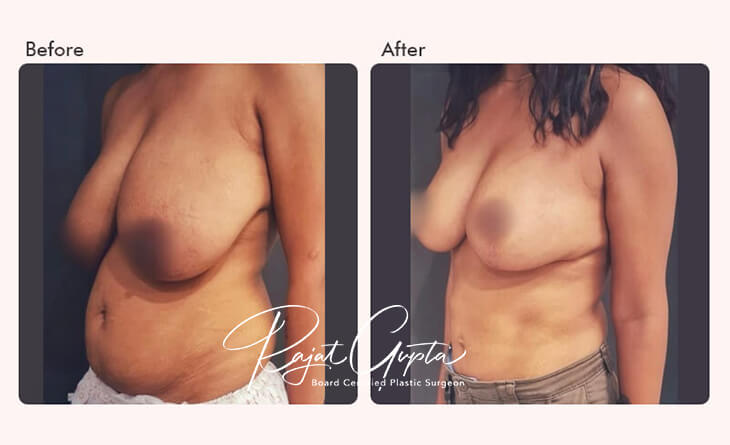
Have questions or want to get started? We are ready to help you with a smile!
Why Some Reductions Lose Their “Top Curve”?
Many traditional reductions remove weight and lift the nipple; however, they may not actively build and support the upper pole. Over the next months, tissue can settle downward; the top looks flatter while the lower pole feels heavier. An upper pole fullness breast reduction solves this gap by engineering support where it is needed. The RG Flap uses your own tissue as an internal bolster; it gives projection that withstands time, movement, and gravity better than simple debulking alone.
What Exactly is the RG Flap?
Clarity matters; here is the technique in plain language. The RG flap breast reduction Delhi plan preserves a superior or superomedial pedicle to maintain blood flow and sensation. From the lower or central breast tissue, the surgeon builds a centrally based autologous flap; the flap is then shaped and anchored to the upper pole to recreate gentle fullness. Because the volume is your own tissue, the contour feels soft and natural; there is no implant edge; there is no foreign material. That is the core innovation behind this dual flap technique breast reduction.
The effect is twofold. Weight is reduced to relieve symptoms, and the top curve is rebuilt so that clothing and posture look balanced. This is a defining difference of the Dr Rajat Gupta RG flap technique compared with reductions that focus only on removal.
Step by Step: How the Procedure Unfolds
It helps to picture the flow before looking at the bullet points; then we will close with what this sequence means for your recovery and shape.
- Marking and planning: With you standing, the surgeon maps the new nipple level, resection zones, pedicle choice, and the geometry of the internal flap so both sides match.
- Pedicle preservation: A superior or superomedial pedicle is defined to protect nipple perfusion and keep sensation whenever possible.
- Flap creation: A centrally based flap is fashioned from your own tissue; thickness and width are tailored to the breast footprint so the flap will sit naturally.
- Anchoring and shaping: The flap is anchored to the upper pole; the lower pole is debulked and supported so the breast does not look bottom-heavy.
- NAC reposition and closure: The nipple–areola complex is moved to its planned position; layered closure supports shape and scar quality; drains are used selectively if needed.
The takeaway is simple. Each move is designed to keep you safe; protect form; and deliver an upper pole fullness breast reduction that holds its curve.
Step by Step: How the Procedure Unfolds
It helps to picture the flow before looking at the bullet points; then we will close with what this sequence means for your recovery and shape.
- Marking and planning: With you standing, the surgeon maps the new nipple level, resection zones, pedicle choice, and the geometry of the internal flap so both sides match.
- Pedicle preservation: A superior or superomedial pedicle is defined to protect nipple perfusion and keep sensation whenever possible.
- Flap creation: A centrally based flap is fashioned from your own tissue; thickness and width are tailored to the breast footprint so the flap will sit naturally.
- Anchoring and shaping: The flap is anchored to the upper pole; the lower pole is debulked and supported so the breast does not look bottom-heavy.
- NAC reposition and closure: The nipple–areola complex is moved to its planned position; layered closure supports shape and scar quality; drains are used selectively if needed.
The takeaway is simple. Each move is designed to keep you safe; protect form; and deliver an upper pole fullness breast reduction that holds its curve.
Recovery You Can Plan Around
A predictable timeline helps you organise work and family. Most patients walk the same day and go home with support garments and clear instructions. Desk work usually resumes around one week; gentle activity builds through weeks two and three; then routine workouts return by week six with surgeon clearance. Scar care begins as advised; silicone therapy and massage are introduced when appropriate; and supportive bras protect shape while tissues settle. This cadence is part of the Dr Rajat Gupta RG flap technique; it keeps healing on track and the upper pole curve supported.
Think of recovery as a partnership. You follow garment guidance and activity pacing; the surgical design does the rest. That balance is what sustains the upper pole contour over the first months and beyond.
Outcomes You Will Notice in Real Life
Patients often describe three changes. The back and neck feel lighter; the breast footprint looks narrower and lifted; and the upper pole shows a soft, rounded curve that reads as youthful in everyday clothing. Because the projection comes from your own tissue, the silhouette looks natural and remains comfortable over seasons. This is the practical promise of an upper pole fullness breast reduction built on a dual flap technique breast reduction rather than implants.
Over time, swelling fades and scars mature; the flap continues to support the top curve. Follow-ups fine-tune scar care and bra choices so the RG flap breast reduction Delhi result stays comfortably in place.
Risks and How They Are Minimised
Any operation carries risks such as bruising, delayed healing, asymmetry, or temporary sensation change. The RG Flap is planned around pedicle reliability and vascularised tissue; these principles help protect nipple viability and reduce bottom heaviness later. Adhering to scar care, garment support, and scheduled reviews further reduces problems and protects the curve you have just gained. This safety-first mindset is why many choose a breast reduction specialist in Delhi for this technique.
A Clear Next Step to Take
If you want smaller, lighter breasts with a soft, youthful top curve that lasts, meet the RG flap breast reduction Delhi pathway. Book a personal mapping session with a breast reduction specialist in Delhi to plan size, lift, and support; then complete your transformation with the Dr Rajat Gupta RG flap technique designed for natural upper pole fullness without implants.
FAQs: Questions Women Ask About RG Flap Technique
Breastfeeding potential is often preserved because the superior or superomedial pedicle maintains critical ducts and blood supply. Sensation is protected by preserving nerve pathways whenever possible; temporary changes can occur; most improve with time. A consultation clarifies your personal likelihood.
Moderate fluctuations are common and usually do not undo the shape because the centrally based autologous flap provides structural support. Large weight swings can stretch the skin envelope; your surgeon counsels on stability so the upper pole fullness breast reduction remains consistent.
Scar patterns depend on your footprint and reduction amount; commonly, a vertical scar with or without an inframammary component. Layered closure, taping, and silicone therapy help scars mature; sun protection and massage are introduced when appropriate. Over time, most scars fade and sit discreetly under clothing.
Drains are used selectively based on tissue handling; if placed, they are usually short-term. Home care focuses on clean dressing, support bras, gentle mobility, and hydration. Your team provides written guidance and review dates so you feel supported.
Yes, many plans add targeted liposuction to refine the lateral contour. The combination is decided case by case, so safety time, recovery, and garment support all align. This is part of the Dr Rajat Gupta RG flap technique customisation.
A well-fitted support bra without underwire is recommended during early healing; it protects the flap and maintains position. Your surgeon advises how to transition to sports bras and everyday styles as tissues settle; this protects the dual flap technique breast reduction shape.
Yes, asymmetry is addressed by tailoring flap size, resection amounts, and nipple position on each side. The planning step in standing is where symmetry goals are set and measured; follow-ups allow fine-tuning as swelling resolves.
Dr. Rajat Gupta
MBBS, MS, DNB(Gen. Surg.),
DNB (Plastic Surgery)
Dr. Rajat Gupta is a board certified plastic surgeon in India with 15 years of experience to back his expertise in the domain of aesthetic surgeries.
Having completed his training from Maulana Azad Medical College and equipped with a thorough understanding of aesthetic needs of people, Dr. Gupta strives to offer the best remedies and cosmetic procedures outfitted with the latest technology to the aspirants in India and across the globe. To book an appointment, call: +91-9251711711 or email: contact@drrajatgupta.com

